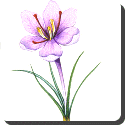 Crocus — Crocus (plural: crocus, crocuses) is a genus of perennial flowering plants, native to a large area from coastal and subalpine areas of central and southern Europe (including the islands of the Aegean), North Africa and the Middle East, across Central Asia to western China.
Crocus — Crocus (plural: crocus, crocuses) is a genus of perennial flowering plants, native to a large area from coastal and subalpine areas of central and southern Europe (including the islands of the Aegean), North Africa and the Middle East, across Central Asia to western China.
The genus Crocus is placed botanically in the iris family (Iridaceae). The plants grow from corms and are mainly hardy perennials, and are found a wide range of habitats, including woodland, scrub and meadows.
There are about eighty species of crocus (of which approximately 30 are cultivated). Their cup-shaped, solitary, salverform flowers taper off into a narrow tube. Their color varies enormously, although lilac, mauve, yellow and white are predominant. The grass-like, ensiform leaf shows generally a white central stripe along the leaf axis. The leaf margin is entire. All crocuses typically have three stamens. The spice saffron is obtained from the stigmas of Crocus sativus, an autumn/fall-blooming species.
The name of the genus is derived from the Greek krokos (attested in Homer’s Iliad, Book XIV, verse 347), this in turn being a Semitic loanword (Hebrew karkom, Aramaic kurkama, Persian and Arabic kurkum, all meaning saffron or saffron yellow). In Greek, the word is also used for the similarly colored egg yolk.
Most crocus species and hybrids should be planted in a sunny position, in gritty, well-drained soil, although a few prefer shadier sites in moist soil. Some are suitable for naturalising in grass. The corms should be planted about 3–4 cm deep; in heavy soils a quantity of sharp grit should be dug in to improve drainage.
 Kids Portal For Parents India Kids Network
Kids Portal For Parents India Kids Network






